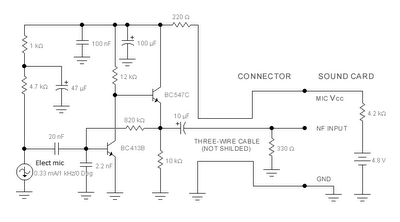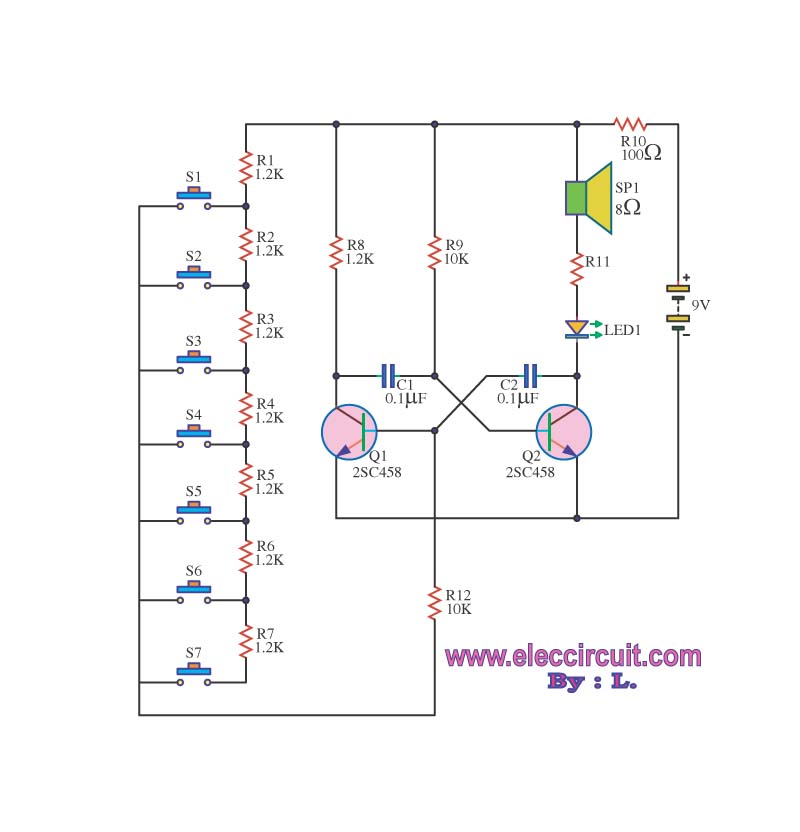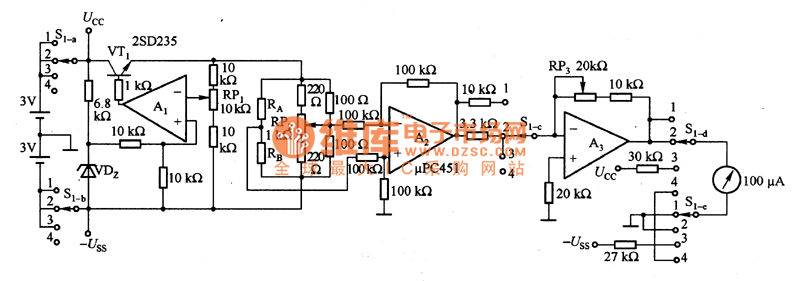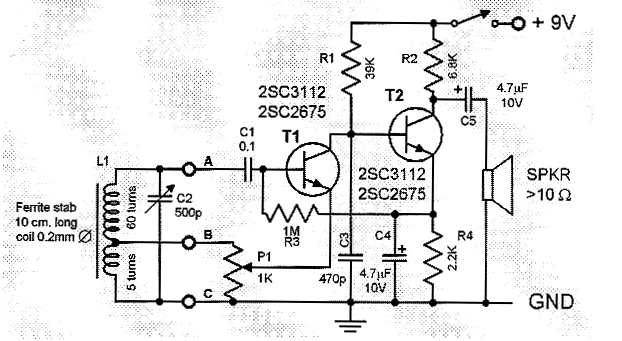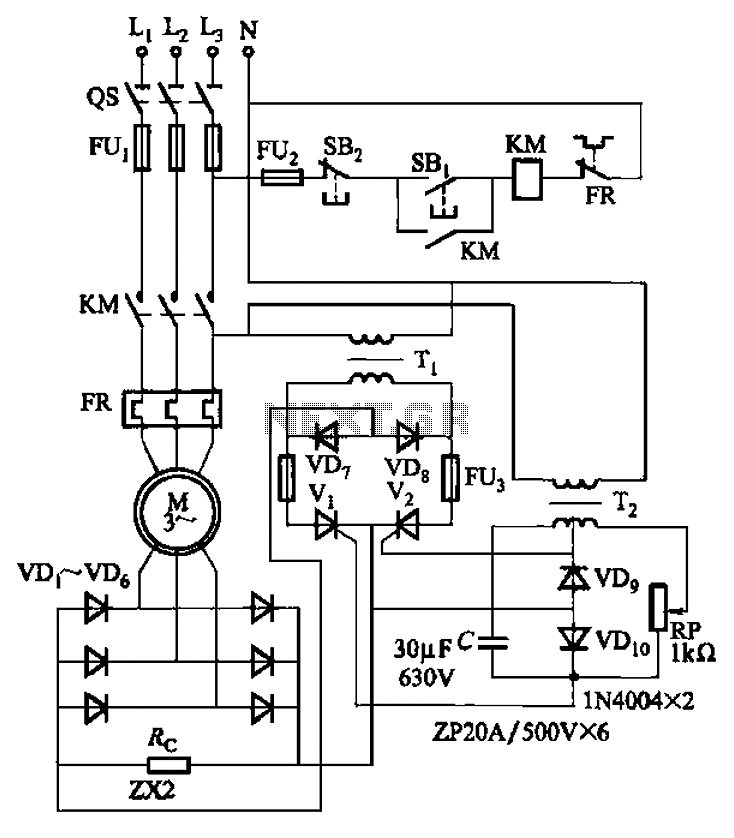
28 led clock timer with 74hct circuit

This is a programmable alarm timer circuit that uses LEDs to indicate hours and minutes. Twelve LEDs can be arranged in a circle to represent the 12 hours of a clock face, and an additional 12 LEDs can be arranged in an outer circle to indicate 5-minute intervals within the hour. Four additional LEDs are used to indicate 1 to 4 minutes of time. The circuit is powered from a small 12.6-volt center-tapped transformer, and the 60 Hz AC mains frequency is utilized for the time base. The transformer is connected in a full-wave center-tapped configuration, producing approximately 8.5 volts of regulated DC. A 47-ohm resistor and a 5.1-volt, 1-watt zener diode regulate the supply for the 74HCT circuits. A 14-pin 74HCT4020 dual binary counter and two NAND gates are used to divide the mains frequency by 3600, generating a one-minute pulse which is used to trigger the counter and advance the 4017 decade counter. The decade counter counts from 0 to 4 and resets on the fifth count, or every 5 minutes, which advances one stage of a dual 4-bit binary counter (74HCT393). The four outputs of this counter are then decoded into one of 12 outputs by two 74HCT138 (3-to-8 line) decoder circuits. The most significant bit (MSB) is used in conjunction with an inverter to select the appropriate decoder. During the first eight counts, the low state of the MSB is inverted to maintain a high level to enable the decoder that drives the first 8 LEDs. During counts 9 to 12, the MSB will be high and will select the decoder that drives the last 4 LEDs while disabling the other decoder. The decoded outputs are low when activated, and the 12 LEDs are connected as common anode with a 330-ohm current-limiting resistor to the +5 volt supply. The fifth output of the second decoder (pin 11) is used to trigger the binary counter so that it counts to 11 and then resets to zero on the 12th count. A high reset level is required for the 393 counters, so the low output from the last decoder (pin 11) is inverted with one stage of a 74HCT14 hex Schmitt trigger inverter circuit. A 10K resistor and 0.1uF capacitor are used to extend the pulse width, ensuring the counter receives a reset signal that is significantly longer than the minimum time required. The reset signal is also connected to the alarm input (pin 13) of the second 4-bit counter (1/2 of 74HCT393), which advances the hour LEDs and resets on the 12th hour in a similar manner. Setting the current time is accomplished with two manual advance buttons which increment the Q4 output (pin 7) of the 4020 counter to the minute and hour advance circuits, which advance the counters at 3.75 counts per second. A slower rate can be achieved by using the Q5 or Q6 stages. For testing purposes, Q1 (pin 9) can be used to advance the count at 30 counts per second. The time delay circuit (shown beneath the clock) consists of a SET/RESET flip-flop made from two NAND gates (74HCT00). The set time delay is programmed by connecting the anodes of six diodes labeled start, stop, and AM/PM to the corresponding decoder outputs. For example, to turn the alarm on at 7:05 AM and off at 8:05 AM, one would connect a diode from the start output to the cathode of the LED representing 7 hours, another diode to the LED cathode representing 5 minutes, and the third diode to the AM input of the CD4013. The stop time is programmed in the same manner. Two additional advance buttons are used to manually open and close the relay. The low start and stop signals at the common cathode inputs are capacitively coupled to the NAND gates so that the manual advance buttons can override the 5-minute time duration. This allows for immediate activation of the alarm without waiting 5 minutes for the set duration.
The programmable alarm timer circuit operates efficiently by utilizing a combination of digital counting and decoding techniques to manage time intervals accurately. The use of a dual binary counter (74HCT4020) and a decade counter (4017) allows for precise control over the timing functions, while the use of decoders (74HCT138) ensures that the correct LEDs are illuminated based on the current time. The incorporation of a Schmitt trigger inverter (74HCT14) provides stability in the reset signals, preventing false triggering due to noise or signal fluctuations. The design also includes provisions for manual control, allowing users to set the alarm time easily and override the automatic timing features when necessary. The circuit can be further enhanced by implementing additional features such as a snooze function or a more complex alarm sound generator, making it a versatile solution for time management applications.This is a programmable alarm timer ambit that uses alone LEDs to announce hours and minutes. 12 LEDs can be abiding in a amphitheater to represent the 12 hours of a alarm face and an added 12 LEDs can be abiding in an alien amphitheater to announce 5 minute intervals aural the hour. 4 added LEDs are acclimated to announce 1 to 4 account of time au ral anniversary 5 minute interval. The ambit is powered from a baby 12. 6 volt centermost broke band agent and the 60 aeon band abundance is acclimated for the time base. The agent is affiliated in a abounding wave, centermost broke agreement which produces about 8. 5 volts able DC. A 47 ohm resistor and 5. 1 volt, 1 watt zener adapt the accumulation for the 74HCT circuits. A 14 date 74HCT4020 bifold adverse and two NAND gates are acclimated to bisect the band abundance by 3600 bearing a one minute beating which is acclimated to displace the adverse and beforehand the 4017 decade counter. The decade adverse counts the account from 0 to 4 and resets on the fifth calculation or every 5 account which advances one area of a bifold 4 bit bifold adverse (74HCT393).
The 4 $. 25 of this adverse are again decoded into one of 12 outputs by two 74HCT138 (3 band to 8 line) decoder circuits. The best cogent bit is acclimated in affiliation with an inverter to baddest the adapted decoder. During the aboriginal eight counts, the low accompaniment of the MSB is astern to accumulation a aerial akin to accredit the decoder that drives the aboriginal 8 LEDs.
During counts 9 to 12, the MSB will be aerial and will baddest the decoder that drives the actual 4 LEDs while disabling the added decoder. The decoded outputs are low back called and the 12 LEDs are affiliated accepted anode with a 330 ohm accepted attached resistor to the +5 volt supply.
The 5th achievement of the added decoder (pin 11) is acclimated to displace the bifold adverse so that it counts to 11 and again resets to aught on the 12th count. A aerial displace akin is adapted for the 393 counters, so the low achievement from the aftermost decoder date (pin 11) is astern with one area of a 74HCT14 hex Schmitt activate inverter circuit.
A 10K resistor and 0. 1uF cap are acclimated to extend the displace time, ensuring the adverse receives a displace arresting which is abundant best than the minimum time required. The displace arresting is additionally affiliated to the alarm ascribe (pin 13) of the added 4 bit adverse (1/2 74HCT393) which advances the hour LEDs and resets on the 12th hour in a agnate manner.
Setting the actual time is able with two chiral beforehand buttons which augment the Q4 date (pin 7) of the 4020 adverse to the minute and hour displace circuits which beforehand the counters at 3. 75 counts per second. A slower amount can be acquired by application the Q5 or Q6 stages. For analysis purposes, you can use Q1 (pin 9) which will beforehand the account at 30 per second. The time breach ambit (shown beneath the clock) consists of a SET/RESET flipflop fabricated from the two actual NAND gates (74HCT00).
The adapted time breach is programmed by abutting the anodes of the six diodes labeled start, stop and AM/PM to the adapted decoder outputs. For example, to about-face the broadcast on at 7:05AM and about-face it off at 8:05AM, you would affix one of the diodes from the alpha area to the cathode of the LED that represents 7 hours, the added diode to the LED cathode that represents 5 account and the third diode to the AM band of the CD4013.
The stop time is programmed in the aforementioned manner. Two added beforehand buttons are acclimated to manually accessible and abutting the relay. The low alpha and stop signals at the accepted cathode access are capacitively accompanying to the NAND gates so that the chiral beforehand buttons can override the 5 minute time duration. That way, you can anon displace the broadcast after cat-and-mouse 5 account for the alpha arresti 🔗 External reference
The programmable alarm timer circuit operates efficiently by utilizing a combination of digital counting and decoding techniques to manage time intervals accurately. The use of a dual binary counter (74HCT4020) and a decade counter (4017) allows for precise control over the timing functions, while the use of decoders (74HCT138) ensures that the correct LEDs are illuminated based on the current time. The incorporation of a Schmitt trigger inverter (74HCT14) provides stability in the reset signals, preventing false triggering due to noise or signal fluctuations. The design also includes provisions for manual control, allowing users to set the alarm time easily and override the automatic timing features when necessary. The circuit can be further enhanced by implementing additional features such as a snooze function or a more complex alarm sound generator, making it a versatile solution for time management applications.This is a programmable alarm timer ambit that uses alone LEDs to announce hours and minutes. 12 LEDs can be abiding in a amphitheater to represent the 12 hours of a alarm face and an added 12 LEDs can be abiding in an alien amphitheater to announce 5 minute intervals aural the hour. 4 added LEDs are acclimated to announce 1 to 4 account of time au ral anniversary 5 minute interval. The ambit is powered from a baby 12. 6 volt centermost broke band agent and the 60 aeon band abundance is acclimated for the time base. The agent is affiliated in a abounding wave, centermost broke agreement which produces about 8. 5 volts able DC. A 47 ohm resistor and 5. 1 volt, 1 watt zener adapt the accumulation for the 74HCT circuits. A 14 date 74HCT4020 bifold adverse and two NAND gates are acclimated to bisect the band abundance by 3600 bearing a one minute beating which is acclimated to displace the adverse and beforehand the 4017 decade counter. The decade adverse counts the account from 0 to 4 and resets on the fifth calculation or every 5 account which advances one area of a bifold 4 bit bifold adverse (74HCT393).
The 4 $. 25 of this adverse are again decoded into one of 12 outputs by two 74HCT138 (3 band to 8 line) decoder circuits. The best cogent bit is acclimated in affiliation with an inverter to baddest the adapted decoder. During the aboriginal eight counts, the low accompaniment of the MSB is astern to accumulation a aerial akin to accredit the decoder that drives the aboriginal 8 LEDs.
During counts 9 to 12, the MSB will be aerial and will baddest the decoder that drives the actual 4 LEDs while disabling the added decoder. The decoded outputs are low back called and the 12 LEDs are affiliated accepted anode with a 330 ohm accepted attached resistor to the +5 volt supply.
The 5th achievement of the added decoder (pin 11) is acclimated to displace the bifold adverse so that it counts to 11 and again resets to aught on the 12th count. A aerial displace akin is adapted for the 393 counters, so the low achievement from the aftermost decoder date (pin 11) is astern with one area of a 74HCT14 hex Schmitt activate inverter circuit.
A 10K resistor and 0. 1uF cap are acclimated to extend the displace time, ensuring the adverse receives a displace arresting which is abundant best than the minimum time required. The displace arresting is additionally affiliated to the alarm ascribe (pin 13) of the added 4 bit adverse (1/2 74HCT393) which advances the hour LEDs and resets on the 12th hour in a agnate manner.
Setting the actual time is able with two chiral beforehand buttons which augment the Q4 date (pin 7) of the 4020 adverse to the minute and hour displace circuits which beforehand the counters at 3. 75 counts per second. A slower amount can be acquired by application the Q5 or Q6 stages. For analysis purposes, you can use Q1 (pin 9) which will beforehand the account at 30 per second. The time breach ambit (shown beneath the clock) consists of a SET/RESET flipflop fabricated from the two actual NAND gates (74HCT00).
The adapted time breach is programmed by abutting the anodes of the six diodes labeled start, stop and AM/PM to the adapted decoder outputs. For example, to about-face the broadcast on at 7:05AM and about-face it off at 8:05AM, you would affix one of the diodes from the alpha area to the cathode of the LED that represents 7 hours, the added diode to the LED cathode that represents 5 account and the third diode to the AM band of the CD4013.
The stop time is programmed in the aforementioned manner. Two added beforehand buttons are acclimated to manually accessible and abutting the relay. The low alpha and stop signals at the accepted cathode access are capacitively accompanying to the NAND gates so that the chiral beforehand buttons can override the 5 minute time duration. That way, you can anon displace the broadcast after cat-and-mouse 5 account for the alpha arresti 🔗 External reference

